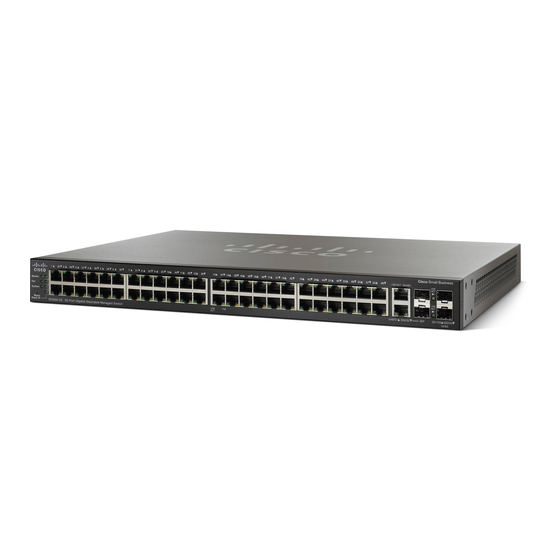
Cisco 500 Series Quick Start Manual
Stackable managed switches
Hide thumbs
Also See for 500 Series:
- Configuration manual (1140 pages) ,
- Administration manual (653 pages) ,
- Quick start manual (72 pages)
Table of Contents
Advertisement
Quick Links
Advertisement
Table of Contents

Summary of Contents for Cisco 500 Series
-
Page 1: Quick Start Guide
Quick Start Guide 500 Series Stackable Managed Switches... - Page 2 Welcome Thank you for choosing the Cisco 500 Series Stackable Managed Switch, a Cisco network communications device. This device is designed to be operational right out of the box as a standard layer 2 and 3 switch. In the factory default configuration, it will forward packets between connecting devices after power up.
-
Page 3: Rack-Mount Placement
19-inch rack. For stability, load the rack from the bottom to the top, with the AUTION heaviest devices on the bottom. A top-heavy rack is likely to be unstable and might tip over. 500 Series Stackable Managed Switches... -
Page 4: Connecting Network Devices
LAN to be operational after it is connected. This is normal behavior. 500 Series switches have both standard Ethernet and stack ports. Standard ethernet ports can not be used for stacking. Refer to... - Page 5 Configuring the 500 Series Stackable Managed Switch Before You Begin Verify the managing computer requirements in the product release notes. The switch can be accessed and managed by two different methods; over your IP network using the web-based interface, or by the Command Line Interface (CLI) through the console port.
- Page 6 Enter the default login information: • Username is cisco • Default password is cisco (passwords are case sensitive) If this is the first time that you have logged on with the default Change Password Page username and password, the opens. The rules for constructing a new login and password are displayed on the page.
- Page 7 Enter a user name and password. User names and passwords are both case sensitive and alpha-numeric. The default username is cisco, and the default password is cisco. If this is the first time that you have logged on with the default...
-
Page 8: Stacking The Switches
Stacking the Switches Before configuring the switches as a stack, refer to the Cisco 500 Series Stackable Managed Switch Administration Guide for additional details. Refer to the front panel graphics in External Features of the Cisco 500 Series Stackable Managed Switch, page 12 to help with the stack port descriptions and supported modules. - Page 9 Sx500s or all SG500Xs). • Basic Hybrid—A device in Basic Hybrid mode can be connected to other devices of the 500 series to form a stack. The only limitation (and the reason that this mode is called Basic Hybrid as opposed to Advanced Hybrid) is that there is no support for VRRP or RIP.
- Page 10 • Advanced Hybrid—A device in Advanced Hybrid mode can be connected to other devices of the 500 series to form a stack. In this mode, VRRP and/or RIP are supported. In this mode, auto numbering of units is not supported, because only the SG500X devices can function as master/backup.
- Page 11 These two connection options (S1 and S2 or S1/SFP and S2/SFP) cannot run at the same time, they are configured as one or the other. Any connections using the SFP ports take precedence over the other combination ports. 500 Series Stackable Managed Switches...
-
Page 12: Front Panel
Speed—1G or 100M • Ports S3 and S4 are configured as standard networking ports – Speed—1G External Features of the Cisco 500 Series Stackable Managed Switch This section describes the exterior of the switches including ports, LEDs, and connectors. Front Panel The ports and LEDs are located on the front panel of the switch. -
Page 13: Right Side
MGBLX1, MGBBX1, MFELX1, MFEFX1, and MFEBX1, as well as other brands of modules. • Cisco SFP+ optical modules that are supported in the 500X switches are: SFP-10G-SR, SFP-10G-LRM, and SFP-10G-LR. • The 500 and 500X switches support the following SFP+ Copper Cable modules for stacking: SFP-H10GB-CU1M, SFP-H10GB-CU3M, and SFP-H10GB-CU5M. -
Page 14: Front Panel Leds
1000 Mbps or nothing is cabled to the port. SFP (if present)—(Green) Located on the right of a GE port. Lights steady when a connection is made through the shared port. Flashes when the port is passing traffic. 500 Series Stackable Managed Switches... -
Page 15: Reset Button
• To restore the switch configuration to the factory default settings: 1. Disconnect the switch from the network or disable all DHCP servers on your network. 2. With the power on, press and hold the Reset button for more than 10 seconds. 500 Series Stackable Managed Switches... -
Page 16: Troubleshoot Your Connection
LED. You can determine the current IP address of the switch through the console port interface by using the CLI, or from your network administrator. Make sure that no other device is using the same IP address as the switch. 500 Series Stackable Managed Switches... - Page 17 Most connections will be available in a few seconds. Due to the standard spanning tree loop detection logic, adding new connections might take 30 to 60 seconds for the affected interfaces and/or LAN to become operational. 500 Series Stackable Managed Switches...
-
Page 18: Where To Go From Here
Cisco Support and Resources www.cisco.com/go/smallbizhelp Phone Support Contacts www.cisco.com/en/US/support/tsd_cisco_ small_business_support_center_contacts.html Cisco Firmware Downloads www.cisco.com/go/smallbizfirmware Select a link to download firmware for Cisco Small Business Products. No login is required. Product Documentation Cisco Switches www.cisco.com/go/500switches Regulatory, Compliance, and www.cisco.com/en/US/docs/switches/lan/ csb_switching_general/rcsi/Switch_RCSI.pdf... - Page 19 500 Series Stackable Managed Switches...
- Page 20 Cisco and the Cisco logo are trademarks or registered trademarks of Cisco and/or its affiliates in the U.S. and other countries. To view a list of Cisco trademarks, go to this URL: www.cisco.com/go/trademarks. Third-party trademarks mentioned are the property of their respective owners.















